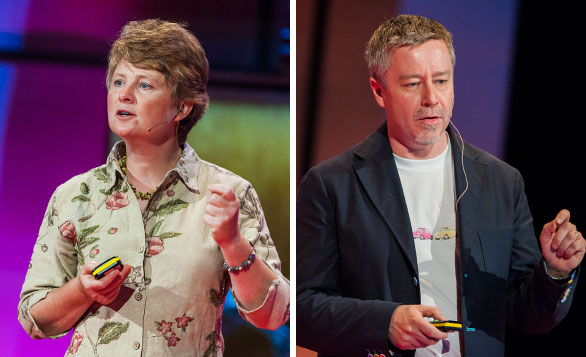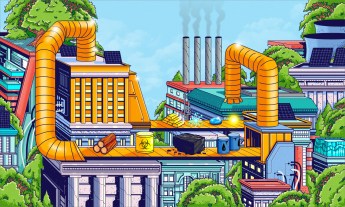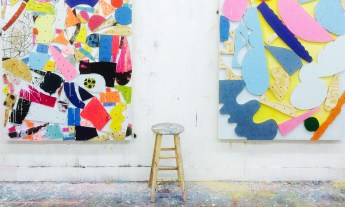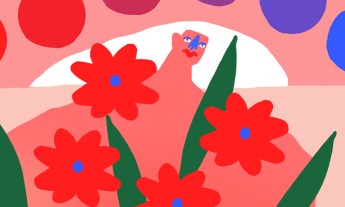
What’s that too-often quoted aphorism? “Good artists copy; great artists steal”? In this nuanced conversation, biologist and founder of Biomimicry 3.8 Janine Benyus speaks with Tim Brown, chief executive of IDEO, to discuss what’s really interesting about borrowing.
Tim Brown: As a creative person, I’ve always believed that I can’t be creative unless I’m inspired in some way. Inspiration is a funny thing; it sounds like it’s an internal thing. We think of great creative artists and imagine that inspiration wells up inside of them, but I think that’s just not true. Inspiration comes from the outside. The most inspirational people are the most observant people who are able to take from the outside world and convert what they see into something that drives their creativity. The simplest and most effective way of doing that is to notice things, and to notice those things that might be relevant to the thing you’re thinking about or the problem you’re trying to solve or the idea that you’re working with. There are countless cliche examples of this, everyone from Picasso to Leonardo, people we think of as being individually creative geniuses who in fact were extremely good at taking inspiration from the outside world and having it drive their own creative engine. Borrowing from the outside world is at the heart of all things we do creatively to be inspired.
Then, the challenges we tackle as designers are always multifaceted; they are systemic in nature, not simple. In order to tackle them with any degree of comprehension we have to look at them from a multidisciplinary perspective, look at them from many different directions, through many different lenses. So we’re not just borrowing from other disciplines, we’re actually applying those disciplines. I think often what we do as designers is attempt to glue a whole bunch of other disciplines together to look at something creatively. We take business, science and technology, the human disciplines of social science… I personally borrow ideas from those places, and much more importantly I am also interested in how we bring them all together as collaborators.
Janine Benyus: That feels like it goes right to the heart of it. Obviously biomimicry is borrowing nature’s blueprints, recipes and processes, borrowing ecosystem strategies and then coming up with design principles to solve our own problems. When I started in this field about 15 years ago, there wasn’t really a name for this method of innovating, and I remember I found that so strange. We used to live much closer to the ecosystem and when we admired species that we saw, we mimicked them. So Native Americans saw the snowshoe hare with its big back feet and made snowshoes that exactly mimicked how they allowed it to float on top of snow. So there’s obviously a long history of it, but why isn’t it systematized? Why isn’t there, in other words, a science around this? There are very deep methodologies around learning about nature, but not about learning from nature.
So when I look at our relationship with the natural world, I think biomimicry signals something very new for western industrial culture. Our relationships with the natural world are around what we can extract, what we can harvest, what we can domesticate. Look through the literature, and we know all about crop plants and livestock, and we know about pests, things that bother us. But until recently we hadn’t studied organisms so that we might learn from them. So I think it’s a new relationship, and it’s also one that is powerful for another reason. If you’re not domesticating, harvesting, or extracting, if you’re just borrowing an idea, that means the organism stays out there in the wild, and so it’s the least damaging thing you can do.
TB: That expands to thinking about how we borrow and are inspired by nature’s systems, those things that aren’t necessarily ‘living’ in the traditional sense of the world. I think of the weather system, for instance, and the overlap with the science of complexity. More and more I’m seeing that we can look at, wonder about and be inspired by things from many different perspectives. One way is to look directly at the specific octopus or mollusk; another is to begin to understand some of the principles of physics from which those natural systems were built. Because unless you’re of a certain religious perspective, they weren’t actually designed by anybody but they emerged from complex systems in seemingly magical ways.
JB: We work with so-called life’s principles. As scientists, we looked and saw all this incredible diversity: ‘wow, that organism can fly at that speed and live without oxygen for three hours!’ There are all those individual technologies — and 30 million species! So we wanted to know if there’s anything that all or even most species have in common. Because that would be an operating manual for how to live on earth. So we began to collect them. And now we work with these principles as a filter. Some of them look at how complex adaptive systems grew to be sustainable or actually enhance their place; they’re almost a buildup of rule sets. And actually, that intrigues me when I think about your work at IDEO. How do you guys make generations of products before they have to go out into the wild? You make stuff, and then you have to select what will live or die. How might things like a list of life’s principles be used to choose the things that will bring us toward better adaptation on the planet? Do you think about stuff like that?
TB: Yes, we do. Not so much the principles that you’re talking about, although it sounds like we should be thinking about them a lot more, but I think you bring up a very important point. The simplistic view of borrowing is that you see a solution here and you apply that solution there. And that works sometimes, but it doesn’t work very often. We see this in our work when we’re doing ethnographic and anthropological work. You’ll see an instance of somebody doing something interesting; they’re an extreme user, they’re hacking the system somehow. The obvious thing is to just take that solution and apply it wherever you’re looking to solve a problem. But it turns out that very rarely works. What you actually have to do is to abstract out what it is you’re learning from that solution, understand what the principles are, understand perhaps what the strategies are, and then from there reformulate the right solution for the circumstances that you’re talking about. This process of spotting, seeing, observing and then abstracting — and then from that abstraction being able to create multiple potential solutions — is an important subtlety when it comes to this idea of borrowing. Ideas don’t just shoot across from the moment you saw an interesting new idea straight through to a solution. Instead, we go through this elevated process of abstraction to the point where we’ve got a set of principles through which we can design many different potential answers.
JB: Very much so! When people talk about biomimicry, they constantly ask questions like, ‘why would you want reinvent things like the spider?’ And that’s not it at all. We look at the spider and we extract a design principle from it. Or the Namibian beetle that can create water out of fog. You’re not going to recreate the shell, but you realize that there’s a design principle for how to do it. It’s a platform.
TB: A great example of this is the work Neri Oxman is doing at MIT. She’s taking the principles of the way silkworms produce their silk, which can be both a very soft material or a very hard material, and she’s exploring the kinds of things you can do by applying those principles. She’s not just trying to make industrial-sized, mechanical silkworms.
JB: Exactly! And the thing that makes Neri’s work really powerful is to figure out how nature makes what we call functional gradients, so you go from a piece of fiber being very stretchy to a piece of fiber being very hard. That’s done with different titrations of the exact same material. So as she puts that different structure function catalog together, and you add 3D printing to the mix, suddenly you’re able to dial in the function you want, using a common raw material that normally you’d think might not be strong enough. That becomes a platform for manufacturing in a new way. The thing to do now is to get deep biological catalogs in place for 3D printing.We’ll do that not by looking at one organism, but by looking across, from ‘amoeba through zebra.’
TB: It’s interesting. This ability to move from the specific to the general through figuring out what the principles are is a fundamental part of the creative process. But it’s something that’s often missed when we have this discussion about how we’re inspired from the outside world or how we borrow ideas.
JB: I remember being at an event in San Diego, and there were a bunch of people from biomimetic companies on a panel. One of them talked about finding a 3D Fibonacci sequence — everywhere. It’s in the cochlear of your ear, it’s in your veins, it’s found in tree tracheids. It’s how water is able to move quickly through capillaries. That shape itself is a platform technology. And so now that company can make fans, blowers, pipes that move water better… Also on the panel was a guy from Regen Energy, and he was talking about using swarm technology. He was so excited to apply that technology to other, new ideas. Once you get a platform, that’s when it becomes very powerful.
TED: Tim, you’ve hired biologists and those with all sorts of backgrounds at IDEO. How do you integrate a few people with the depths of knowledge that Janine is describing into the company — and how do you make sure their ideas are fostered and nurtured and not just seen as a happy, interesting, weird sideline?
TB: It’s actually really difficult, and I would say we’re less successful than I’d like us to be, even though we keep doing it. We’re not a huge organization by global standards, but we’re big enough, 600 people, and when you come in with a very specific set of expertise, there’s immediately a tension: ‘What is the right thing to do?’ Should people remain expert in what they do? In which case they’re basically on their own, as there aren’t other similar people in the organization. Or should they, as we say, go native and essentially turn themselves into a designer? In which case their skillset is essentially lost and certainly no longer deepening. We’ve run across that problem with scientists, with all kinds of people where it’s unlikely that we’re going to have 50 of them. The strategy, I think, and one that we have to keep working on, is you both bring people in as experts, and also build outside networks and collaborate. That’s the way those experts stay deep in their field, and it’s also the way we can create leverage and scale.
JB: We’ve gotten to that point as well, where I think we realize that we’re not going to be able to stop everything and give everybody a deep knowledge of the biological world. People are not going to become biologists. What we think we need to do — and have started — is to create a “Biological Intelligence Service.” The hope is to make this into a digital resource where people can look up any kind of function and come up with a lot of the biological strategies. It’s early days right now, but I think we have to have biologists do something they haven’t really done, which is to find patterns that then become useful as principles for design. It’s the process we do for clients, but I think it has to be something that everybody can subscribe to. I want us to get to the point where we’re in the tools people use every day, when biology is at that level of abstraction where it’s useful. So you don’t just learn that the beetle can comb water out of fog, you actually have a generative design program, an algorithm, that allows you to skin your train or your car with that particular shape, so you can wrap a building so that it too can comb water out of fog. The knowledge actually turns into a product that comes out of biological intelligence. So far in biology we’ve been in stamp-collecting mode; we’ve been very interested in cataloging the diversity of life and not that interested in cataloging its generalities. So this is new.
TB: What we also need, at least in order for designers to respond well to this, are the icons, if you like, the things that spark our imagination. And so as we begin to get designers, people like Neri, for instance, who are beginning to make exciting discoveries and expressing them in a creative, design-based way, that inspires other designers to think the same way. So it’s one thing to have a library of solutions, another to have tools, algorithms, whatever else it might be that will help you match a need with a solution. Then I think we also need those things that inspire us and the examples that pull us toward this space, which means we need these crossover people. Neri’s interesting because she’s an architect and a scientist, so she’s got both skills. Particularly in the early days, the translational difficulties that we have between designers and biologists get overcome by people who are somehow both things. They’re few and far between, but when we find them, I think they play a really important role.
JB: Absolutely. They’re the da Vincis.
TED: You’ve both been vocal about the need for both design and biomimicry to be used and applied to stop us from destroying the planet and ourselves. How do you see that movement progressing?
TB: Janine pointed at a bunch of the most interesting examples, but this idea that we might be discovering principles for making our own man-made world, and using mechanisms, principles and materials that are in themselves far more sustainable, because biology has figured out how to do that, that for me is the most exciting piece of it. There’s also a piece that’s harder to understand and harder to get your head around because it’s much more complex, which is understanding the way that nature’s systems and sustainable ecosystems actually work. That’s why I think the science of complexity is so important. At the actionable level, this idea that we might be developing 3D printing materials that are both highly adaptable structurally and at the same time highly circular in their ability to be returned back to where they came from, that is where I think the great hope lies.
Of course, we’ve also got the rather small challenge of persuading the world’s industries to completely retool the way they think about what they do. It took a couple hundred years to get to this point and we haven’t got a couple hundred years to get to the next point, so that’s a significant challenge. But certainly for me, even in the last couple years as I’ve started to see the possibilities for making in these new ways, I’m the most hopeful I’ve been that we might have an alternative. I’m not saying we’re there yet, but this is not just about improving the state of the way we do things industrially today, but completely remaking it.
JB: I completely agree, and I think the circular economy piece is very interesting. But even once you agree that these materials are reusable, a lot of innovation has to happen everywhere along that line in order for that to happen. You have to start with materials that can be reconfigured, taken apart, unzipped — even before 3D printing comes online. We need to start thinking about the supply chain, of what we’re putting in those printers. I think biomimicry has the design; the build files for those 3D printers can come from the natural world. Now we’re also going to have to get nature’s chemistry within those printers. And that’s a huge and exciting challenge.
Note: This conversation was lightly edited. “Questions Worth Asking” is a TED editorial series; this week we asked the question, “Can I borrow that?” to dig into themes of cross-disciplinary innovation and idea-sharing. See also Seth Godin’s op ed, “Why I want you to steal my ideas,” a story about SkyBox Imaging, a company using unexpected technology to build a new type of satellite, and an interview with Suzanne Lee, who’s mixing science, fashion and kombucha to extraordinary effect.




















